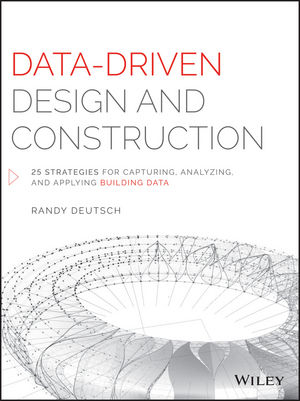
Data-Driven Design and Construction
John Wiley & Sons Inc (Verlag)
978-1-118-89870-3 (ISBN)
“In this comprehensive book, Professor Randy Deutsch has unlocked and laid bare the twenty-first century codice nascosto of architecture. It is data. Big data. Data as driver. . .This book offers us the chance to become informed and knowledgeable pursuers of data and the opportunities it offers to making architecture a wonderful, useful, and smart art form.”
—From the Foreword by James Timberlake, FAIA
Written for architects, engineers, contractors, owners, and educators, and based on today’s technology and practices, Data-Driven Design and Construction: 25 Strategies for Capturing, Applying and Analyzing Building Data
addresses how innovative individuals and firms are using data to remain competitive while advancing their practices.
seeks to address and rectify a gap in our learning, by explaining to architects, engineers, contractors and owners—and students of these fields—how to acquire and use data to make more informed decisions.
documents how data-driven design is the new frontier of the convergence between BIM and architectural computational analyses and associated tools.
is a book of adaptable strategies you and your organization can apply today to make the most of the data you have at your fingertips.
Data-Driven Design and Construction was written to help design practitioners and their project teams make better use of BIM, and leverage data throughout the building lifecycle.
Randy Deutsch, AIA, LEED AP is an Associate Professor at the University of Illinois, a BIM authority and architect responsible for the design of over 100 large, complex sustainable projects. A recipient of the AIA Young Architect Award-Chicago, Randy is recognized as a professional thought and practice leader, TEDx and keynote speaker, and author of BIM and Integrated Design: Strategies for Architectural Practice (Wiley, 2011). He is a frequent contributor to DesignIntelligence and leads a Harvard Graduate School of Design Executive Education program at Harvard University. Randy consults and presents internationally.
Foreword xiii
James Timberlake, FAIA, Partner, KieranTimberlake
Preface xv
Acknowledgments xxiii
Introduction: Measuring the Immeasurable, Validating the Ineffable 1
Not One More Thing 1
Strategies for Practice 2
Benefits of Gathering, Analyzing, and Applying Building Data 4
Challenges of Gathering, Analyzing, and Applying Building Data 13
Strategy No. 1: Hone in on Key Information 17
Strategy No. 2: Demonstrating Works, Explaining Doesn’t 20
PART I Why Data, Why Now? 27
Chapter 1 The Data Turn 29
Five Factors Leading to the Leveraging of Data and Industry Change 29
Strategy No. 3: Look Outside the Industry 32
Case Study Interview with Robert Yori 37
Strategy No. 4: Not Big Data, Smart Data 54
Case Study Interview with Sean D. Burke 55
Data versus Documents 61
Case Study Interview with Jonatan Schumacher 63
Chapter 2 A Data -Driven Design Approach for Buildings 71
Five Trends Leading to the Rise of Data in the AECO Industry 71
Strategy No. 5: Eight Questions to Ask for Data Preparedness 73
Case Study Interview with Zigmund Rubel 75
Data-Centric Approaches 84
Case Study Interview with Andrew Heumann 86
Strategy No. 6: Four Steps toward Making the Change to Be More Data-Centric 87
Strategy No. 7: Ask Good Questions 88
Case Study Interview with Jonathon Broughton 96
Chapter 3 Learning from Data 107
Five Factors Ensuring Data Preparedness 107
Training, Learning, and Working with Data 110
Case Study Interview with Brian Ringley 113
Strategy No. 8: Play with Data 123
Case Study Interview with Toru Hasegawa 126
Case Study Interview with Aimee Buccellato 134
PART II Capturing, Analyzing, and Applying Building Data 141
Chapter 4 Capturing and Mining Project Data 143
Public Sources of Data 143
Case Study Interview with Ryan Mullenix 145
Private Data Sources 153
Case Study Interview with Sam Miller 157
Having a Data Collection Strategy 169
Strategy No. 9: Create a Data Collection Strategy 169
Case Study Interview with Gregory Janks 170
Strategy No. 10: First Steps to Becoming Data-Centric 174
Chapter 5 Analyzing Data 179
Analysis versus Analytics 179
Strategy No. 11: First Steps in Applying Data Analysis 180
Predictive Analytics 180
Case Study Interview with Mads Jensen 182
Strategy No. 12: Two Ways to Think about Energy Analysis 191
Strategy No. 13: Analysis for Sustainable Design 192
Case Study Interview with Chris Pyke, PhD 198
Strategy No. 14: How Analysis Informs Decision Making 201
Strategy No. 15: Start Simple, Technology Optional 202
Strategy No. 16: Leverage Data as Means to an End 203
Case Study Interview with Brendon Levitt 203
Dhour Case Study 209
Chapter 6 Applying Data 213
First Steps 213
Strategy No. 17: First Steps Before Applying Data 214
Strategy No. 18: Plan for the Data 215
Case Study Interview with Billie Faircloth 216
Data-Enabled Project Teams 222
Strategy No. 19: Should the Data Team Be Integrated or Stationed in the Corner? 225
Case Study Interview with Andrew Witt 226
Data-Intensive Roles 230
Strategy No. 20: Computer Scientist vs. Emerging Professional 231
Case Study Interview with Greig Paterson 235
Leadership in Data 238
PART III What Data Means for You, Your Firm, Profession, and Industry 241
Chapter 7 Data in Construction and Operations 243
Data in Construction 244
Strategy No. 21: Construction-Related Data Questions 245
Case Study Interview with Tyler Goss 246
Responding to Change 250
Case Study Interview with Mani Golparvar-Fard, PhD 250
Linking Design, Construction, and Operations 259
Strategy No. 22: Extract and Transfer What Matters 261
Case Study Interview with Bill East, PhD 262
Standards and Interoperability 266
Case Study Interview with Greg Schleusner 267
Chapter 8 Data for Building Owners and End Users 273
Benefits to the Owner 273
Case Study Interview with Sukanya Paciorek 274
Direction to Work with Data 277
Case Study Interview with Peter Pellerzi 279
Strategy No. 23: with Data, the Heart of the Issue Is Culture 280
AECO Firms as Data Intermediaries 281
Case Study Interview with Brian Skripac 282
Data Visualization Helps Owners Make Decisions 285
Case Study: Data Viz Using Revit 286
Case Study Interview with Evelyn Lee 293
Data-Driven Design Driven by Owners 296
Chapter 9 Building a Case for Leveraging Data 297
Business Intelligence (BI) and Current-State Assessment 297
Fee and Profitability Data Case Study 298
Case Study Interview with David Fano and Dr. Daniel Davis 300
Strategy No. 24: Big Data in Practice 301
Security and Privacy 310
Case Study Interview with Mark Frisch, FAIA, LEED AP BD+C 312
Sharing Data 324
Case Study Interview with David Sawdey 325
Strategy No. 25: Use Data to Provide Better Service 326
Epilogue
The Future Of Data In AEC 331
Our Data-Driven Future 331
The Future Is Already Here 333
Appendix 337
Experts, Innovators, and Thought Leaders Interviewed 337
Organizations and Universities Represented 338
The 25 Data-Driven Strategies 339
Software Mentioned 339
Recommended Reading 341
Index 343
| Verlagsort | New York |
|---|---|
| Sprache | englisch |
| Maße | 191 x 234 mm |
| Gewicht | 1043 g |
| Themenwelt | Technik ► Architektur |
| Technik ► Bauwesen | |
| ISBN-10 | 1-118-89870-2 / 1118898702 |
| ISBN-13 | 978-1-118-89870-3 / 9781118898703 |
| Zustand | Neuware |
| Informationen gemäß Produktsicherheitsverordnung (GPSR) | |
| Haben Sie eine Frage zum Produkt? |
aus dem Bereich


